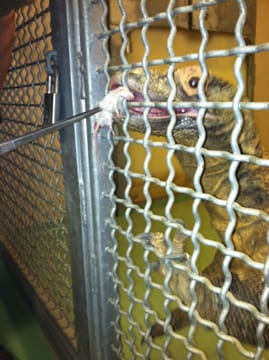
An elephant waving at you, ears moving back and forth. Seeing zebras and giraffes moving to your right, and magnificent rhinos to your left, more present than any HD TV. The power of a komodo dragon’s jaws as he grasps the food on tongs you hold.
It’s all at the neighborhood Zoo.
One adventure is Twiga Terrace, a deck within the Zoo’s African Plains area that stretches far into the giraffe habitat. Beautifully designed and remarkably effective, guests receive a leaf of romaine to offer to the world’s tallest animal. Indescribably graceful, they move behind Zoo Atlanta’s CEO Raymond King as he speaks to the media March 28 about the Terrace and the beginnings of Wildlife Encounters.
“One of our missions is to connect our guests as closely as we can to animals that are normally in the wild. Most of these kids, and most of us, can’t go to Africa. But you know, we can let them feed a giraffe. And that’s pretty remarkable. I’ve had the honor of doing it and to go face to face with a giraffe. It’s somewhat life changing. It connects you to that animal in an entirely different way.”
Whether you feed a giraffe or simply go onto Twiga Terrace, the experience is remarkable. King points out, “As we look out to the left there are black rhinos, one of the most highly endangered animals in the world that has been under siege in recent years by poachers who have great technology and can fly a helicopter in and kill a rhino and then just come take his tusk off and go away and leave him. Just atrocious kind of happenings, so being able to get closer to that is meaningful to us.”
One challenge in the coming weeks will be to train the animals; specifically the giraffes. On Media Day they came close but did not quite reach us. Not surprising with the reporters and camera people crowding the deck. But the experience was no less for the lack of feeding; the very closeness is breathtaking. This reaction is normal. King shared he was with a group a few days prior, and “…just being out here. The giraffes were not in the mood to feed..and I can tell you, that group went home mesmerized. That’s one of the reasons we’re doing Wildlife Encounters, too; it’s to connect you to that animal in a way that goes beyond a sign that tells you where it’s from and let’s you have a really personal encounter.”
Wildlife Encounters doesn’t just go beyond a sign; it goes beyond feeding. This program enables you to go behind the scenes, talk to the keepers, and learn about how the species is trained, how they live, and how the staff deals with them. Encounters range from 30 minutes (komodo dragon) to well over an hour (giant panda). Elephant encounters include demonstrations of enrichment, care, elephant pedicures, training behaviors, and their purpose.
But the hit for both boys and many parents is sure to be Slasher, the komodo dragon. Nine feet long and exotic in every sense, the unnerving flicker of the reptile’s forked tongue becomes both endearing and admirable. “His tongue picks up scents in the air,” Slasher’s keeper explains, “which allows him to smell in stereo. It not only allows him to smell what’s coming but what direction it’s coming from.”
As of March 31, encounters can be with African elephants and the komodo dragon, with giant pandas coming soon. The initiative developed internally through a partnership with the education department, the animal welfare department that takes care of the animals on a daily basis, and the vet specialists. King stressed, “Animal welfare drives everything we do.” Thus there may be days when the giraffes will have reached their food quota, and the feeding will be closed. Wild encounters are limited, both by the number of participants and when one is offered.
It’s all part of the Zoo’s mission to drive awareness of these animals; not only to expand a child’s experience of places far away, but also to foster conservation and responsible stewardship of current and future generations. To encounter an exotic animal is to change; and change can bring action. Raymond King and the Atlanta Zoo believe this. “We want people to find a way to get more engaged in supporting wildlife. It doesn’t have to be financially; it can be tweeting and blogging and Facebooking what their experience was.”
Bigger picture aside, who doesn’t want to feed an animal that lives around the world? King says, “I couldn’t think of a much better gift for somebody’s birthday or special occasion than to say, “I’m going to take you behind the scenes, and you’re going to get to feed a panda bear.”









Comments are closed.